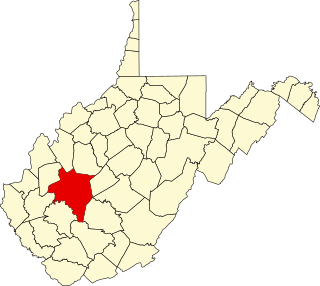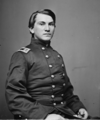The Confederate order of battle during the Battle of Gettysburg includes the American Civil War officers and men of the Army of Northern Virginia. Order of battle compiled from the army organization during the battle, the casualty returns and the reports.

The Third Battle of Winchester, also known as the Battle of Opequon or Battle of Opequon Creek, was an American Civil War battle fought near Winchester, Virginia, on September 19, 1864. Union Army Major General Philip Sheridan defeated Confederate Army Lieutenant General Jubal Early in one of the largest, bloodiest, and most important battles in the Shenandoah Valley. Among the 5,000 Union casualties were one general killed and three wounded. The casualty rate for the Confederates was high: about 4,000 of 15,500. Two Confederate generals were killed and four were wounded. Participants in the battle included two future presidents of the United States, two future governors of Virginia, a former vice president of the United States, and a colonel whose grandson, George S. Patton became a famous general in World War II.
The Battle of Lynchburg was fought on June 17–18, 1864, two miles outside Lynchburg, Virginia, as part of the American Civil War. The Union Army of West Virginia, under Maj. Gen. David Hunter, attempted to capture the city but was repulsed by Confederate Lt. Gen. Jubal Anderson Early.

The Battle of Cove Mountain occurred in Wythe County, Virginia, on May 10, 1864, during the American Civil War. A Union cavalry division commanded by Brigadier General William W. Averell was prevented from attacking a lead mine located near Wytheville. Confederate forces commanded by Brigadier General John Hunt Morgan, with a detachment of a brigade of cavalry from the command of Brigadier General William E. "Grumble" Jones, stopped Averell at Cove Gap, adjacent to Crockett's Cove and Cove Mountain.

The Battle of Charleston was a Confederate victory in Kanawha County, Virginia, on September 13, 1862, during the American Civil War. Troops led by Major General William W. Loring defeated a Union force led by Colonel Joseph Andrew Jackson Lightburn. This battle, which featured extensive use of artillery but few casualties, was the second major fight in Loring's Kanawha Valley Campaign of 1862 that succeeded in driving Union forces out of the Kanawha River Valley. All points in the Kanawha River Valley were in the southwestern part of Virginia at the time of the battle, but are now part of the state of West Virginia.

The Battle of Droop Mountain occurred in Pocahontas County, West Virginia, on November 6, 1863, during the American Civil War. A Union brigade commanded by Brigadier General William W. Averell defeated a smaller Confederate force commanded by Brigadier General John Echols and Colonel William L. "Mudwall" Jackson. Confederate forces were driven from their breastworks on Droop Mountain, losing weapons and equipment. They escaped southward through Lewisburg, West Virginia; hours before a second Union force commanded by Brigadier General Alfred N. Duffié occupied the town.
The following Confederate States Army units and commanders fought in the Battle of Antietam of the American Civil War. The Union order of battle is listed separately. Order of battle compiled from the army organization during the campaign, the casualty returns and the reports.
The following Union Army units and commanders fought in the Battle of Chancellorsville of the American Civil War. The Confederate order of battle is listed separately. Order of battle compiled from the army organization during the battle, the casualty returns, and the reports.

The 1st West Virginia Cavalry Regiment served in the Union Army during the American Civil War. Although it started slowly, it became one of the most active and effective of the West Virginia Civil War regiments—and had 14 Medal of Honor recipients, the most for any West Virginia regiment during the war. It was originally called the 1st Virginia Cavalry, not to be confused with the Confederate 1st Virginia Cavalry. Some reports added "Union," "Loyal" or "West" when identifying this regiment. After the Unionist state of West Virginia was officially admitted to the Union in 1863, the regiment became the 1st West Virginia Cavalry Regiment. The National Park Service identifies it as the 1st Regiment, West Virginia Cavalry.

The 2nd West Virginia Cavalry Regiment served in the Union Army during the American Civil War. It was organized in Parkersburg, Virginia during September 1861. Most of the original members of this regiment were from southeastern Ohio, and planners thought that this regiment would become the 4th Ohio Cavalry. Their application was rejected by the governor of Ohio, so the unit became the 2nd Regiment of Loyal Virginia Volunteer Cavalry. The "Loyal Virginia" part of the name was replaced with "West Virginia" after the state of West Virginia was officially admitted to the Union in 1863. Today, the National Park Service lists them as 2nd Regiment, West Virginia Cavalry under a heading of Union West Virginia Volunteers.

The 22nd Virginia Infantry Regiment was an infantry regiment from the western Virginia that served in the Confederate States Army during the American Civil War. Its commander was George S. Patton Sr., the grandfather of World War II General George S. Patton.
The following Union Army units and commanders fought in the Third Battle of Winchester in the American Civil War. The Confederate order of battle is listed separately. The battle was fought on September 19, 1864 near Winchester, Virginia, and Opequon Creek. The battle is also known as the Battle of Opequon or the Battle of Opequon Creek.

The 45th Virginia Infantry Regiment was an infantry regiment raised in the Commonwealth of Virginia for service in the Confederate States Army during the American Civil War. It fought mostly in the mountainous area that today encompasses the border regions of Virginia and West Virginia, and was part of Jubal Early's Army of the Valley during the Valley Campaigns of 1864.
The following Confederate Army units and commanders were the initial structure on April 30, 1862 of the Confederate Army of Northern Virginia during the Peninsula campaign of the American Civil War. It contains units throughout Virginia that influenced the campaign. The Union order of battle is listed separately.

Chapman's Artillery was an artillery battery in the Confederate States Army during the American Civil War. It was organized by George Beirne Chapman and was mustered into Confederate service at Lewisburg on April 25, 1862, with 150 men recruited from Monroe County, Greenbrier County, Allegheny County, and Roanoke County.

The following army units were involved in the Battle of Droop Mountain on November 6, 1863, near Hillsboro, West Virginia, in the American Civil War. Hillsboro, spelled "Hillsborough" on some maps from that century, is located in the mountainous terrain of Pocahontas County, West Virginia. A Union brigade commanded by Brigadier General William W. Averell defeated a smaller Confederate force commanded by Brigadier General John Echols and Colonel William L. "Mudwall" Jackson. A second Union force commanded by Brigadier General Alfred N. Duffié, tried to prevent the Confederate retreat, but did not engage at Droop Mountain. Aware of Duffié's troops, Confederate forces escaped before he arrived.

The Battle of White Sulphur Springs, also known as the Battle of Rocky Gap or the Battle of Dry Creek, occurred in Greenbrier County, West Virginia, on August 26 and 27, 1863, during the American Civil War. A Confederate Army force commanded by Colonel George S. Patton defeated a Union brigade commanded by Brigadier General William W. Averell. West Virginia had been a state for only a few months, and its citizens along the state's southern border were divided in loyalty to the Union and Confederate causes. Many of the fighters on both sides were West Virginians, and some were from the counties close to the site of the battle.

The 14th Pennsylvania Cavalry Regiment was a cavalry regiment of the Union Army during the American Civil War. Most of its fighting happened in the last half of 1863 and full year 1864. The regiment fought mainly in West Virginia and Virginia, often as part of a brigade or division commanded by Brigadier General William W. Averell and later Brigadier General William Powell.

The Battle of Lewisburg occurred in Greenbrier County, Virginia, on May 23, 1862, during the American Civil War. A Union brigade commanded by Colonel George Crook soundly defeated a larger Confederate force commanded by Brigadier General Henry Heth. Panicked Confederate forces escaped by crossing and burning a bridge across the Greenbrier River.

The 23rd Virginia Infantry Battalion, often called "Derrick's Battalion", was an infantry battalion in the Confederate Army during the American Civil War. It fought mostly in western Virginia and the Shenandoah Valley, and was usually part of a brigade commanded by John Echols or George S. Patton. By 1864, the brigade was usually part of a division commanded by Major General John C. Breckinridge or Brigadier General Gabriel C. Wharton.





















